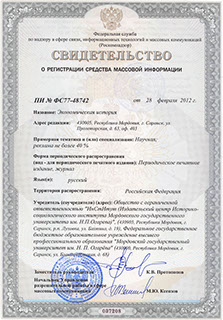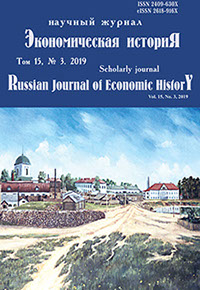Экономическая историЯ
Russian Journal of Economic History
ISSN 2409-630X (Print)
ISSN 2618-916X (Online)
Expert board:
- Scientific Council of RAS on economic history;
- Research and Educational Center «The economic history of Central Russia and the Middle Volga region» of Ogarev Mordovia State University;
- Center of Economic History of Lomonosov Moscow State University
Navigation
Certificate of registration

ISSN 2409-630X (Print), ISSN 2618-916X (Online)
DOI: 10.15507/2409-630X.046.015.201903.274-288
УДК 94:633.522”20”(470.345)
Olga V. Koshina1, Larisa G. Skvorcova2
1 National Research Ogarev Mordovia State University (Saransk, Russia), e-mail: koshinaolga@rambler.ru
2 National Research Ogarev Mordovia State University (Saransk, Russia), e-mail: skvorcovalg@inbox.ru
“Mordovian Silk”: Development of Hemp Growing in Mordovia in the 1930–1950s
Introduction. The development of hemp growing in Mordovia in the 1930s – 1950s attracted attention of researchers due to the recent revival of interest of agricultural producers in the world, Russia and the Republic of Mordovia to the cultivation of hemp and its production. Being unheralded during the second half of the 1980s – 1990s, hemp becomes popular again in the agriculture of the Mordovia Republic, Russia and other countries. Materials and Methods. An integrative approach is used as a theoretical and methodological base of the study, microeconomic processes of a particular region against the background of macroeconomic phenomena are analyzed. Socio-economic approach allows observing the elements of material incentives within the socialist economy. Along with the analysis of economic processes, non-economic factors are taken into account. Results. Despite many climatic, socio-economic and technical problems, the cultivation of hemp in Mordovia in the 1930s – 1950s was highly profitable. Discussion and Conclusions. The success of the hemp growers contributed to: targeted state support for hemp farms, active financial incentives of collective farms and collective farmers, the development of agriculture, as well as non-economic motivation of Soviet peasants. Much success in the production of “Mordovian silk” was made by Atyashevskiy, Dubensky, Zubovo-Polyanskiy, Ichalkovsky, Kochkurovskiy, Krasnoslobodsky and Kadoshkiny districts.
Keywords: hemp, collective farm, hemp straw, fiber, hemp plant, seeds, agronomy, squad leaders, brigades, foremost workers, productivity of land, income, labor day unit.
For citation: Koshina O. V. Skvorcova L. G. “Mordovian Silk”: Development of Hemp Growing in Mordovia in the 1930–1950s. Ekonomicheskaya istoriya = Russian Journal of Economic History. 2019; 15(3): 274–288. (In Russ.). DOI: 10.15507/2409-630X.046.015.201903.274-288.
© Ogarev Mordovia State University. History and Sociology Institute, 2017
68, Of. 411, Bolshevistskaya St., 430005, The editorial office of the scholarly journal «Russian Journal of Economic History»
Tel.: (8342) 24-25-90; 27-07-11, Fax: (8342) 24-25-90, E-mail: jurnal-econom-hist@isi.mrsu.ru
Designed by A. Napalkov, Email: napalkov@isi.mrsu.ru

